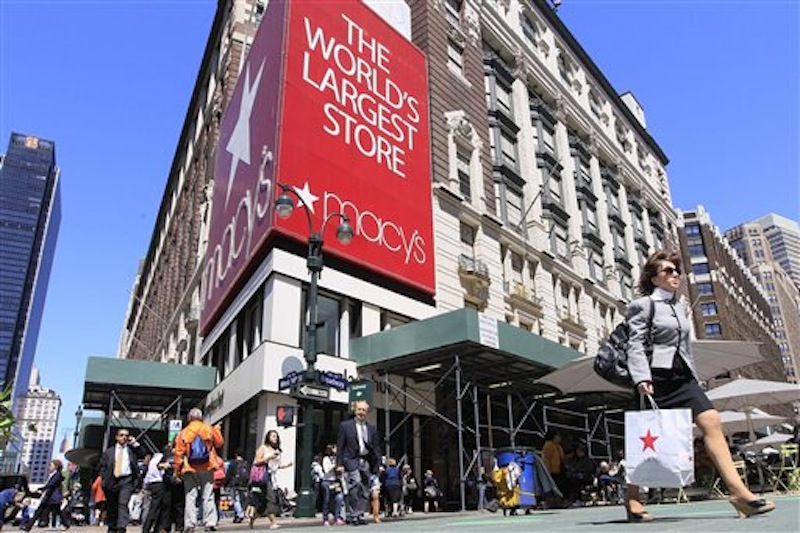NEW YORK — Americans stepped up their spending in February, boosting sales at many stores and offering the latest sign that shoppers are feeling more confident in the economy.
As merchants reported their monthly sales figures Thursday, a diverse group including Target and Macy’s reported sales gains that exceeded Wall Street estimates. Even Gap Inc., long mired in a sales slump, posted an unexpected increase.
The figures, based on revenue at stores opened at least a year, are considered an indicator of a retailer’s health. Only a small group of retailers report monthly sales figures. But industry watchers say those merchants that do post monthly numbers offer a snapshot of consumer spending, which accounts for more than 70 percent of all economic activity.
“This was a very strong month. A new life has been breathed into the retailers,” said Ken Perkins, president of Retail Metrics, a research firm. “Consumers are starting to feel much better about their overall situation.”
Overall, merchants on Thursday reported a 6.7 percent increase for February compared with the year-ago period, according to the International Council of Shopping Center’s tally of 21 retailers. That followed a more modest increase of 2.7 percent in January. February’s results marked the biggest gain since June 2011 when the index was up 6.9 percent as shoppers took advantage of deep promotions on summer merchandise.
An unusually mild winter, which depressed sales of cold weather items like coats during the holiday season, turned out to be a blessing in February. It helped to kick off spending of spring merchandise last month. But what had a bigger impact is the improving economy, which boosted shoppers’ moods during the month to the highest level in a year, according to a widely-watched barometer of consumer confidence released Tuesday by private research group the Conference Board.
Americans particularly are encouraged by the improving job market. The government reported that the unemployment rate fell to 8.3 percent, the lowest in three years and the first time since 1994 that unemployment has dropped five months in a row.
Figures released Thursday showed more signs of improvement: The government reported the number of people seeking unemployment benefits fell slightly last week to the lowest point in four years. Economists expect employers to add another 210,000 jobs when job figures for February are out next Friday, according to FactSet. The unemployment rate should remain unchanged.
The government also reported Thursday that consumers earned a little more in January and spent most of the extra money. The gains should keep the economy growing at a modest pace.
Meanwhile, Wall Street hit two milestones. The Nasdaq composite index briefly touched 3,000 on Wednesday for the first time since the collapse in dot-com stocks more than a decade ago. Stocks ended lower, but it was still the best February on Wall Street in 14 years. That came a day after the Dow Jones industrial average closed above 13,000 for the first time since May 2008.
But there are reasons for some caution. February is the second lowest sales volume generator behind January. So even small increases in spending can exaggerate growth. Adding to that, early spending of spring merchandise in February could hurt retailers’ business going in March.
The European debt crisis is also a lingering issue that could affect the U.S. economy. And rising gas prices could threaten consumer spending particularly among the low-to middle income shopper. The price of gas has jumped 45 cents since Jan. 1 and is the highest on record for this time of year, an average of $3.73 a gallon.
Still, Sherif Mityas, a partner in the retail practice at A.T. Kearney, a management consulting firm, says: “There have been a lot of tailwinds helping retailers.”
Target Corp.’s sales rebounded after a muted holiday shopping season. Its key sales figure rose 7 percent in February as more people came to stores and spent more on core categories such as food and health care products. Analysts expected a 5.2 percent rise.
Excluding the Easter months, which skew results, Target’s increase was the biggest since November 2007 when the figure soared 10.8 percent. That was one month before the recession officially started.
Target, however, said it continues to plan for an increase of around 4 percent for the fiscal first quarter. That suggests that executives believe there’s the possibility business could be pulled forward.
Department-store chain Macy’s Inc., which has had solid results since the recession thanks to its focus on tailoring merchandise to different regions, also reported a sales gain that beat Wall Street estimates. It posted a 4.6 percent increase, better than 3.5 percent increase Wall Street expected.
“We saw good consumer response to our early spring deliveries in women’s apparel, and continued strong trends in accessories, shoes, cosmetics, men’s and home, which bodes well for the months ahead,” said Terry J. Lundgren, chairman, president and chief executive officer of Macy’s in a statement.
Even Gap Inc., which has suffered throughout the recession, said revenue at stores opened at least a year rose 4 percent in February. Analysts had expected a 1.4 percent drop. The figure was helped by strong demand for spring clothing at its Banana Republic chain, but the North America’s divisions of its namesake chain and Old Navy also enjoyed gain. Its international business had a decline.
Copy the Story LinkSend questions/comments to the editors.



Success. Please wait for the page to reload. If the page does not reload within 5 seconds, please refresh the page.
Enter your email and password to access comments.
Hi, to comment on stories you must . This profile is in addition to your subscription and website login.
Already have a commenting profile? .
Invalid username/password.
Please check your email to confirm and complete your registration.
Only subscribers are eligible to post comments. Please subscribe or login first for digital access. Here’s why.
Use the form below to reset your password. When you've submitted your account email, we will send an email with a reset code.